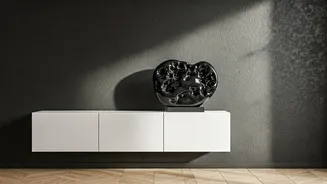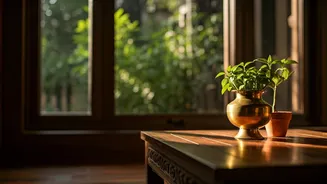Vaastu's Perspective on Black
Vaastu Shastra, the ancient Indian system of architecture, provides a unique lens through which to view colors, including black. Contrary to common perceptions,
Vaastu does not inherently deem black as inauspicious. Instead, it acknowledges black's significant energy properties. Black, in Vaastu, is associated with the element of 'Prithvi,' or earth, and has the ability to absorb and ground energies. This makes it a crucial color when used thoughtfully to create balance and stability within a space. However, it’s the mindful integration that is important, taking into consideration the overall harmony of the environment. The focus is always on creating a balanced energetic flow, and the appropriate utilization of black can contribute to this goal.
Yin and Yang Balance
The principles of Yin and Yang, which represent opposing yet complementary forces, are key to understanding the use of black in Vaastu. Black, with its ability to absorb, is often associated with Yin, the passive, receptive energy. When Yin is in balance with Yang (active energy), the environment feels harmonious. The goal in Vaastu is to maintain a perfect balance. Black can be used to temper excessive Yang energy, such as that associated with bright light or vibrant colors, to facilitate equilibrium. Conversely, in a space that lacks energy or feels overly passive, the strategic use of black could create a more grounded and vital feel. The correct use of black, in essence, is to cultivate a state of equilibrium where both energies can coexist and benefit each other.
Power of Absorption
One of the most noteworthy qualities of black, in the context of Vaastu, is its ability to absorb energy. This is a property that can be used to great advantage. Black can absorb negative energies, creating a purifying effect within the space. It can also absorb heat and light, which makes it useful in warmer climates. But, this ability of absorption necessitates careful consideration. If black is utilized too extensively, it may also absorb positive energies, leading to a sense of stagnation or gloom. When used wisely, black can act as a stabilizing and grounding force, creating a sense of security and protection. Therefore, while black can be a strong absorber, its use must always be balanced to maintain a dynamic and positive environment.
The Right User
The effective use of black in Vaastu is deeply linked to the individual's needs and the specifics of the space. Consider personal preferences and how black complements the overall ambience. Black is generally suitable for grounding spaces such as bedrooms, where it can provide a feeling of security, and for areas where we want to absorb excess energy. If the resident is generally prone to feelings of anxiety or low energy, they should use black sparingly. Conversely, for individuals seeking stability and a sense of grounding, a judicious application of black might be highly beneficial. The right user is someone who uses black consciously, aware of its energetic properties and how they align with their own state of being. The goal is always to create a space that supports and enhances the user's well-being.
Where to Avoid
While black has many positive aspects, it should be used with caution in certain areas according to Vaastu. Generally, it’s best to avoid black in areas where the flow of positive energy is important, such as the entrance of the house, which should be inviting and bright. It's often recommended to avoid black in the children's rooms, because it may have a depressing effect. Similarly, excessive use of black in areas with limited natural light may give a heavy and closed feel. It’s also wise to avoid using black in the kitchen, particularly if the user is concerned about maintaining a sense of warmth and vitality in that space. The careful consideration of the spatial dynamics and the energetic needs of the inhabitants is important when deciding where and how much black to use.














